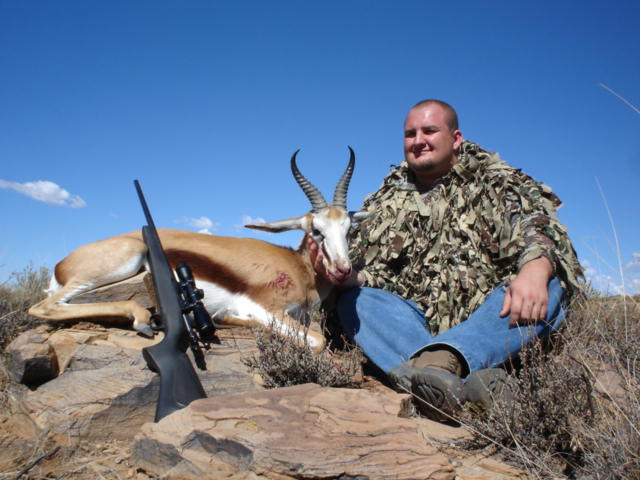
|
|
20/09/07
The prince of the Karoo
By Kobus Fourie
The springbuck (antidorcas marsupialis) is found on the plains of South Africa, through Botswana, Namibia and into Angola. The specie has even been successfully introduced to game ranches in the USA. The springbuck is our South African national emblem, and our sports teams (except the cricket players who changed recently) are known as springbucks. At the turn of the 17th century the springbuck occurred in unbelievable numbers, the enormous herds soon exhausted the grazing in there immediate area, and would migrate en mass to new pastures. These migrations would comprise herds of hundreds of thousands, and the springbuck in these herds are known as ‘trekbokke’ by the locals. These days the migration is a thing of the past, with only the occasional small ( less than 100 ) heard ‘trekking’ through parts of the Free State province, where their movements are not to restricted by fences. The last known large scale migration occurred in 1896 in the Northern Cape.
| Typical terrain of the camp were we hunted the springbok. this photograph show the view from our shooting position down the gully we used for our stalk | 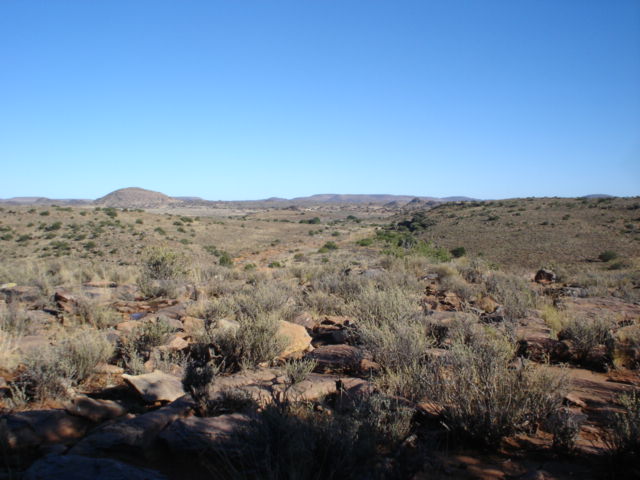 |
The springbuck is the only gazelle found south of Tanzania, and differs from other gazelles in having a fold of skin down the middle of the hind part of the back. The fold cover the area between the central part of the spine to the root of the tail, forming a pouch with the brilliant long white hair on the inside. When exited the pouch is everted and the white hair on the inside show up as a crest some six inches high. Typically the hair is displayed when the springbuck jump into the air, to a height of up to 2.5 meter, and curving its body to open the fan of hair. This display is known as ‘pronking’, and the buck rebounds successively for a few leaps afterwards when it may dash off at high speed. When ‘pronking’ the body is usually held slightly side ways with the head low. To see springbuck ‘pronk’ is truly one of the most beautiful sights in the Karoo. Manny farmers in the Karoo are now farming with springbuck, and they have bred three colour variations. Namely white, black and copper. The white springbuck is completely white, the black bucks retain a hint of the cinnamon brown stripe along the flanks and the copper bucks have the three different colours areas of normal springbuck, just coloured in the most beautiful copper colour.
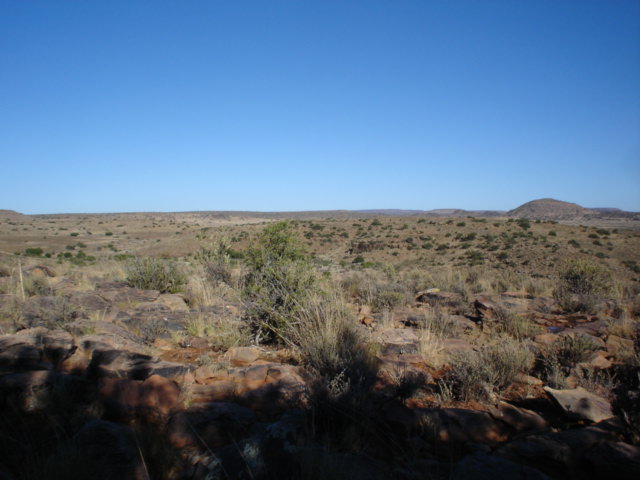 |
The pools of water from the previous night's rain can still be seen in the depressions in the rocks. Nice to hold the water, but murder on hands and knees if you have to crawl over them. |
The springbuck stands 75centimeters tall at the shoulder, and weighs 37 kilograms for a ram, and 32 kilograms for a ewe. These weights are the average for springbuck found through most of their range. There are however bigger bodied springbuck in Namibia, and these springbuck are bought at game auctions and introduced to a farm to breed bigger bodied animals. These bigger buck are known locally as ‘Kalahari bokke’ establishing their origin as the Kalahari, and these bucks can weigh up to 41 kg‘s. Both species carry horns, with those of the ram being thicker at the base and curving more than the slender straighter horns of the females. The horns are lyrate shaped with rings around their base and smooth towards the tip. A male have about 20 rings around the base of its horns. The minimum qualification length for Rowland ward is 14 inches (35.5 cm) and the current record is 19 3/8 inches long, shot in Prospect Namibia in 1973. The number two on the list measures 19 1/8 inches and was shot near Beaufort West in 1961, not to far from where I hunted this springbuck.
When I did the fallow deer hunt in 06, I was fortunate to meet very friendly likeminded people on that particular trip. We all shared a passion for the outdoors, hunting and firearms, and during one of our conversations about guns, Andre Hugo - Wollie to his friends - invited me to his home to show me his Martini Henry rifle. The Martini-Henry has a very colourful history in South Africa. The gun was first introduced by the British as their new military rifle, replacing the Snider in service. The Martini won considerable fame during the Zulu war, with places like Rork’s drift and Isandlewana forever etched in history. The Martini was used by both sides during the first Anglo-Boer war, with Majuba the most famous battlefield to hear the roar of a Martini during that war. By the second Anglo-Boer war the Martini was obsolete, but was still used in limited quantities.
As a result of its use over such a long period of time, there are still many Martinis in private hands, and the romance of shooting one is a powerful experience for anybody interested in South African history and firearms. The most difficult part of shooting one is the availability of ammunition and reloading components. I own a Martini and reload for it, so when Wollie expressed a desire to shoot his, I send him a few of my turned cases. He was so grateful for the cases that he invited me to come and hunt a springbuck on his farm.
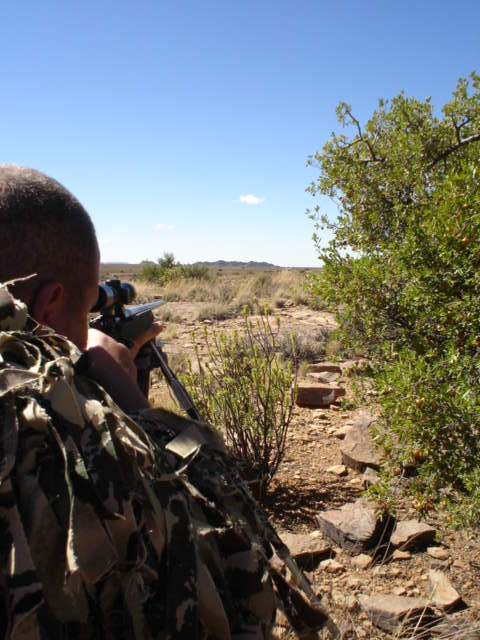 |
Taken seconds after the shots, the low bush in front caused me a lot of problems. I prefer to sit down on my backside in terrain like this were the grass prevent me from laying down, but with this shot I had to kneel to take the shot. |
The farm is situated about halfway between the Karoo towns of Victoria Wes and Carnarvon and is called Bo-Pampoenpoort. For this year the hunting party consist of Tommie his fiancé Nelmarie, Jaco (Jakkals), Wollie and I, with Tommie’s dog, Nghala, the newest addition. I had not seen them since the previous years follow deer hunt, and we thoroughly enjoyed the reunion when we met on the farm the Friday night. Even though our winter in South Africa begins around May, and the fire we made served no heating purpose, it added considerable to the atmosphere, and there is almost nothing better than barbequed Karoo lamb on acacia coals for dinner. Served with generous helpings of good company, it really is unbeatable. That night around the dying embers Wollie told us about the lay of the camp we were to hunt. The farm is about 3000ha in size, with the camp we were allocated about 500 hectares in size. Our allotted camp was the most northern camp of the farm and was called ‘sonderwater’ meaning without water.
This particular camp was not typical Karoo plain, but had a deep ravine running down the middle with undulating little hills on either side. Typical springbuck hunting in the Karoo usually means a driven hunt, or using the vehicle to get close enough for a shot, but Tommie and I prefer to hunt on foot - no matter what the terrain looks like. The advice we got from Wollie and his father was to start early - real early. The camp had not been hunted for a long time, and we expected the animals to be quite calm and relaxed. The hunt started at 4:30 the Saturday morning when we woke up to Nelmarie’s delicious coffee. I prepared my kit, ammo, gun, rangefinder, ghilli suit and a few energy bars to provide some energy during the day. Tommie double checked his Lynx binoculars, sharp knife, tripod and some water for us. At 5:30 everybody was dressed and the cool box was packed for the midday barbeque in the veld. When we set of for the camp we still had to drive with the headlights on.
The rifle I had chosen for this hunt was in 6X45 calibre. A 6X45 is a .223 Remington case necked-up to take a 6mm bullet. The 6X45 cam be build on really small actions, making them very light to carry and handy to use. This particular rifle was built on a Zastava mini-mauser action, and because it is a small light rifle, I selected a 4x32 Lynx compact scope for the rifle. I have a lot of confidence in and experience with Lynx products, and knew the scope will not let me down. I selected a 100gr Hornady round nose bullet to use in the rifle. The 6X45 is on the light side for shots beyond 200 meters, and I knew we would have to get really close before I can take the shot. Being handicapped in such a way only made the hunt more exiting, kind of like taking big fish with a light rod and tackle.
|
|
The four friends after the hunt; Back row - L>R: Me, Jaco (Jakkals)
Andre (Wollie) Front; Tommie |
We arrived at the south eastern corner of the camp just as the sun peaked over the mountains to our right. It was somewhat chilly for this time of year, and I was glad for the little extra warmth as I slipped the ghilli suit over my head. There had been a few scattered light showers during the previous night, and the smell of wet soil in the fresh Karoo air was fantastic. Tommie and I would be the only ones hunting. The others would stay with the vehicles to minimise movement in the camp thereby spooking the springbuck unnecessarily. After the customary good luck wishes, we started walking up the dry river bed that would take us right up the middle of the camp. I had a very busy previous month, and was glad for the chance to clear my head. The soft crunch of the course gravel under my boots were beginning to work its magic, my senses were beginning to come alive, the wonderful smells in the air was getting more complex, my eyes began to notice ever smaller details; I felt alive, I am hunting.
After we walked in the river bed for about 400 meters we turned and started to climb the mountain on our right. As we got higher and higher the view were improving with every step. The rays of the morning sun cast our shadows for meters up the ravine we just left. Upon reaching the top we spotted a small heard of springbuck on the other side of the canyon. A convenient bush provided cover as we sat down to look for a shootable specimen amongst the heard. Whilst Tommie scanned the heard with his binoculars, I marvelled at the beauty before me. Outstretched before me was a river that flowed the same course through the ancient hills for millennia. The bedrock, still damp from the rain, lay glistening in the gentle morning light with the reflection of the sun shimmering against the steep sides of the river bank. Tommie satisfied himself that there was no shootable specimen amongst the heard and we decided to hunt the broken plateau to our right instead.
With the gentle breeze in our face we moved off slowly towards a low ridge 500 meters in front of us. We had barely walked 80 meters when the urgency in Tommie’s voice caused me to kneel down as fast as I could. To our left was a deep stream that ran into the big river, and behind that rise up a ridge running roughly east to west. Tommie had spotted movement on the ridge, and on bringing his binoculars to his eyes had found to his utter amazement a pair of jackal jogging in our direction. We immediately sat down and remained motionless as the jackal approached ever closer. They were big, and beautiful. Their shiny hair glistening in the early morning sunlight. In front was the younger of the two running effortlessly over the low Karoo bushes and stones making straight for us. Behind followed its partner, older wiser and more cautious, stopping every 150meters or so to look and listen. They were both in magnificent condition, and we sat mesmerized as the pair approached ever closer.
On reaching the edge of the stream the first one paused for a brief moment, glanced backwards over his shoulder to its partner and disappeared below the embankment. The other one stayed in sight longer as it chose a different path into the ravine. The pair either had a nice cosy spot to lie in during the day, or they were on their way to quench their first, I can imagine them lapping up water eagerly from the cool, clear pool of water in the river. It is very very rare to see jackal during the day in the Karoo. They cause huge losses to the sheep farmers and their numbers are actively controlled by a number of means. Their unsurpassed ability to adapt and survive made them one of the most challenging adversaries to hunt. I have hunted them on a number of occasions, and have grown to respect and admire their cunning and quickness to learn from the smallest mistake. Seeing these magnificent creatures in their element was one of the most wonderful experiences I have the pleasure to remember. Unfortunately they never came close enough to take any photos.
| Resting after carrying the buck beck to the vehicle. Nghala, the young ridgeback, is laying motionless beside the Springbok. Usually he has too much energy, but this hunt proved to be a little tiring for him as well. |
|
After the wonderful experience we just had, we were both not as alert as we should have been and nearly bumped into a black springbuck that was grazing on its own in front of some low shrub. We sat down and I prepared the tripod while Tommie glassed the buck. Wollie wanted to remove all the black buck from the farm, and I would be doing him a favour by shooting this one. Tommie and I sat for about 10 minutes looking at the buck and discussing weather to shoot it or not. The buck was still young, and he wanted me to go for something bigger whilst I wanted to help Wollie by removing the black buck from the breeding stock. We finally agreed it would be a good idea to take this buck, and I settled down to concentrate on the shot. I ranged the buck at 130 meters, so the shot was a very easy one, at that distance the gun would shoot 2.7 inches above point of aim so I aimed a fraction below the hart and squeezed the trigger.
I could tell from the sound of the shot, or lack thereof, that I missed. The buck gave the characteristic jump in the air and ran for a short distance before turning broadside and looked back at the direction the sound came from. At this point the buck was unaware of our position, but the movement in using the rangefinder would certainly give our very exposed position away. With there being no opportunity to use the rangefinder again, I guessed the amount of holdover needed to get the bullet to the right spot in the springbuck. My judgment was off however and the buck trotted away over the veld, leaving me slowly rolling two empty cases in the palm of my hand wandering what had gone wrong. I think I said something about missing my 260 Remington, but I can’t be sure. We sat there for a further 10 or so minutes enjoying an energy bar whilst waiting for everything to settle down before we started hunting again. I wanted an interesting hunt, and with my confidence very low after the miss, I knew we would have to get even closer if I were to feel any conviction in taking a shot at a springbuck again.
We started of cautiously in the direction the black buck had run. As we came over a low ridge, a heard of springbuck appeared on the ridge over which came the jackal earlier the morning. The wind was however in their favour and there was nothing we could do but watch them run to the other side of the camp after picking up our sent. The camp might not have been hunted in a wile, but nobody told the springbuck. After founding nothing in the low-lying area to our right we walked to the edge of the ravine to see if we could surprise any springbuck that might be on the slope. By this time it was between eight and nine in the morning, and Wollie and Jakkals must have been very bored by now, so the decided to have a look in the neighbouring camp. We saw them on the opposite side of the ravine as we crossed the tracks left by the jackal in the damp earth earlier the morning.
Some of the springbuck grazing on the opposite bank sew them too and started to run in our direction. Normally the springbuck would run until they came to the boundary fence of the camp and then turn right, run through the ravine and would run up our side of the ravine at its lowest point, which was 800 meters in front of us. We realized if we hurry and the herd slowed down, we might reach a suitable shooting position in front of them, and find ourselves able to lay the perfect ambush. The springbuck had other ideas however and we saw them disappear over the hill long before we reached our chosen ambush position.
| A beautiful Springbok ram. We were waiting for the rest of the herd to leave on their own accord, so I was too late to take a picture of the 'pronk' as it opens when the animal die. | 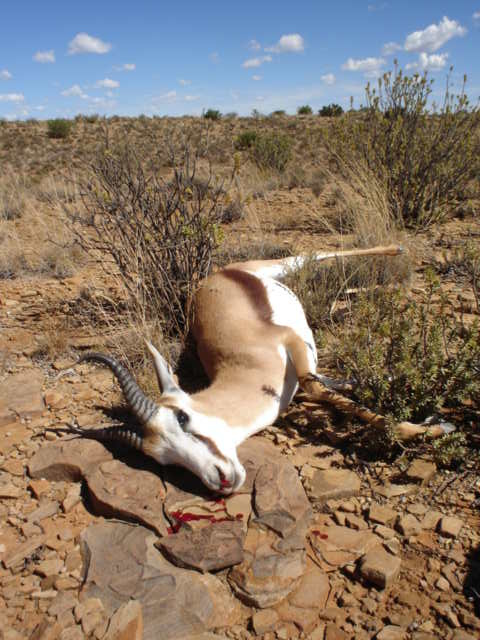 |
By this time we had hunted the entire camp to the right of the ravine, and were sure there that all the springbuck are on the left side by now. We sat down in the shade of a big bush and whilst nibbling on a few jelly sweets, discussed further strategy and talked about the hunt so far. . The time had caught up with us, and we decided to return to the vehicles for lunch. When we had a sat-down, Tommie took out his cigarettes with great anticipation, only to discover he had lost his matches when I took the first shot at the black buck. So when we walked back to the vehicles we had to track ourselves to find his matches. I have tracked a lot of animals before, but a box of Lion matches was a first for me. Upon reaching the vehicles I met Jakkal’s fiancé who had joined the group while me and Tommie were in the field.
While Wollie prepared the fire to barbeque some sausages, I set up a target 75 meter away to see if the miss the morning was the fault of the rifle or mine. I expected the latter, and the two shots in line with point of aim confirmed my suspicion. Another friend of mine always say if someone tell you they have not missed before, they have not hunted often before. I would certainly agree with that. Sometimes it is very difficult to explain those easy shots that miss. I suppose it makes for an interesting hunt, and had I shot the black buck that morning, I would have missed out of a wonderful hunt.
After lunch we climbed the left side of the ravine to hunt the other side of the camp. This time Tommie took his dog Nghala along. Nghala is Sjangaan for Lion, and it is a very apt name for a dog bred to hunt lions. Nghala is a one year old ridgeback and still learning the trade (hunting), so taking him along is very good experience for him, and having hunted with my own ridgeback for almost eight years, I enjoy the company of these excellent dogs. Ridgebacks are one of only two breeds indigenous to southern Africa. The other been the Boerboel dogs bred as guard dogs on farms.
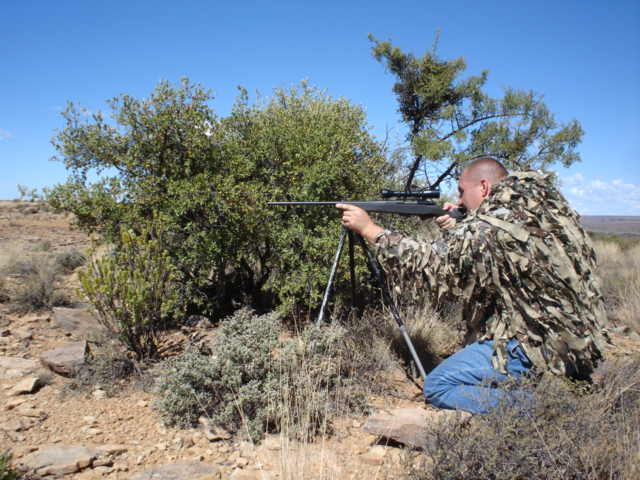 |
This picture illustrates the position I was forced to take thanks to the bush in front of me. Of interest is how effective the Ghilli suit camouflages my left arm, and how clearly the straight lines stand out. |
The afternoon hunt started promising when we spotted 5 or 6 springbuck close to the fence in the adjoining camp. The wind was unfortunately against us again and we could get no shot on the bucks before they high-tailed it out of there. In order to get downwind from the animals in the camp we walked to the corner of the camp before we could start hunting. Under a bush near the corner of the camp I picked up a very old Musgrave .243 case, and could not help but wonder what story the case could tell if it were able to talk. The spot is certainly a good one for a hunter, ample cover with a good field of view over the fall in front of the bush. Tommie nudged me out of my daydream and we descended into the valley in front of us. We were behind a ridge that ran parallel to the ravine, and we had noticed the springbuck preferred the ravine side of the ridge. If they remain where they are, we would have a very good chance of sneaking up on them if we do the stalk right.
We approached carefully, walking slowly, looking for the smallest movement of a horn tip or ear above the horizon. Tommie stood up behind a bush to better see into the depression in front when a springbuck suddenly appeared on a low ridge about a 100meters in front of us. We sat down as quickly as we could and I moved into a shooting position on the left side of the bush. The tripod was set up for me taking the shot sitting down, and I found that the low Karoo bushes in front of me prevented a clear shot sitting down. With trembling fingers I passed my rifle to Tommie and with as little movement as possible, adjusted the legs of the tripod higher. I laid down on my stomach and pulled my legs in under me and sat up. The tripod was the right height now, and I just had to wait for the ram to move away from the ewe behind him. He finally moved towards my left, and presented me with a quartering towards me shot. Tommie whispered “take him” and I squeezed the trigger. This time my aim was true, and the buck dropped on the spot.
 |
A proud moment. I was a long tough hunt, but well worth it in the end. |
We had done the stalk so well that the rest of the herd had no idea where the shot came from, and only ran away after we started to move about five minutes after the shot. All that remained was for us to take the photos, and for Tommie to carry the buck back to the vehicle while I bring the rest of the equipment. This hunt was really hard work. We hunted for seven hours with only the our lunch break, on normal flat terrain it would not be so difficult, but in the undulating terrain we not only walked, but also stalked it proved to be very taxing. I am very glad I used the small 6X45 with its compact lightweight Lynx scope on this particular hunt. It proved reliable (if I do my part) and rugged enough for such a tough hunt.
At the end of last year’s fallow deer hunt I made a pledge to return if the opportunity ever presented itself again. It was again a rich and rewarding experience to share some quality hunting time with some of the most wonderful friends a man can wish for. Now it’s my turn to invite them to were I live, in the bushveld, and repay them in kind for their friendship. I’m looking forward with immense anticipation to hunting with them again. …….but first, somebody mentioned something about a superb location for Bushbuck on the wild coast.